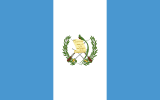Guatemala

About Guatemala
Guatemala (GWAH-tə-MAH-lə; Spanish: [ɡwateˈmala]), officially the Republic of Guatemala (Spanish: República de Guatemala), is a country in Central America bordered by Mexico to the north and west, Belize and the Caribbean to the northeast, Honduras to the east, El Salvador to the southeast and the Pacific Ocean to the south. With an estimated population of around 17.2 million, it is the most populous country in Central America and has the 11th largest national population in the Americas. Guatemala is a representative democracy; its capital and largest city is Nueva Guatemala de la Asunción, also known as Guatemala City.
The core of the Maya civilization, which extended across Mesoamerica, was historically based in the territory of modern Guatemala. In the 16th century, most of this area was conquered by the Spanish and claimed as part of the viceroyalty of New Spain. Guatemala attained independence in 1821 as part of the Federal Republic of Central America, which dissolved by 1841.
From the mid- to late 19th century, Guatemala suffered chronic instability and civil strife. Beginning in the early 20th century, it was ruled by a series of dictators backed by the United Fruit Company and the United States government. In 1944, the authoritarian leader Jorge Ubico was overthrown by a pro-democratic military coup, initiating a decade-long revolution that led to sweeping social and economic reforms. A U.S.-backed military coup in 1954 ended the revolution and installed a dictatorship.From 1960 to 1996, Guatemala endured a bloody civil war fought between the US-backed government and leftist rebels, including genocidal massacres of the Maya population perpetrated by the military. Since a United Nations–negotiated peace accord, Guatemala has achieved both economic growth and successful democratic elections, although it continues to struggle with high rates of poverty and crime, drug cartels, and instability. As of 2014, Guatemala ranks 31st of 33 Latin American and Caribbean countries in terms of the Human Development Index.Guatemala's abundance of biologically significant and unique ecosystems includes many endemic species and contributes to Mesoamerica's designation as a biodiversity hotspot.
Guatemala City
Guatemala City (Spanish: Ciudad de Guatemala), locally known as Guatemala or Guate, officially Ciudad de Guatemala (art. 231 of the Political Constitution of the Republic of Guatemala), is the capital and largest city of Guatemala, and the most populous urban area in Central America. The city is located in the south-central part of the country, nestled in a mountain valley called Valle de la Ermita (English: Hermitage Valley). It is estimated that its population is about 1 million. Guatemala City is also the capital of the Municipality of Guatemala and of the Guatemala Department.
Guatemala City is the site of the Mayan city of Kaminaljuyu, founded around 1500 BC. Following the Spanish conquest, a new town was established, and in 1776 it was made capital of the Kingdom of Guatemala. In 1821, Guatemala City was the scene of the declaration of independence of Central America from Spain, after which it became the capital of the newly established United Provinces of Central America (later the Federal Republic of Central America). In 1847, Guatemala declared itself an independent republic, with Guatemala City as its capital. The city was originally located in what is now Antigua Guatemala, and was moved to its current location in 1777. Guatemala City and the original location in Antigua Guatemala were almost completely destroyed by the 1917–18 earthquakes. Reconstructions following the earthquakes have resulted in a more modern architectural landscape.Today, Guatemala City is the political, cultural, and economic center of Guatemala. It is served by La Aurora International Airport.